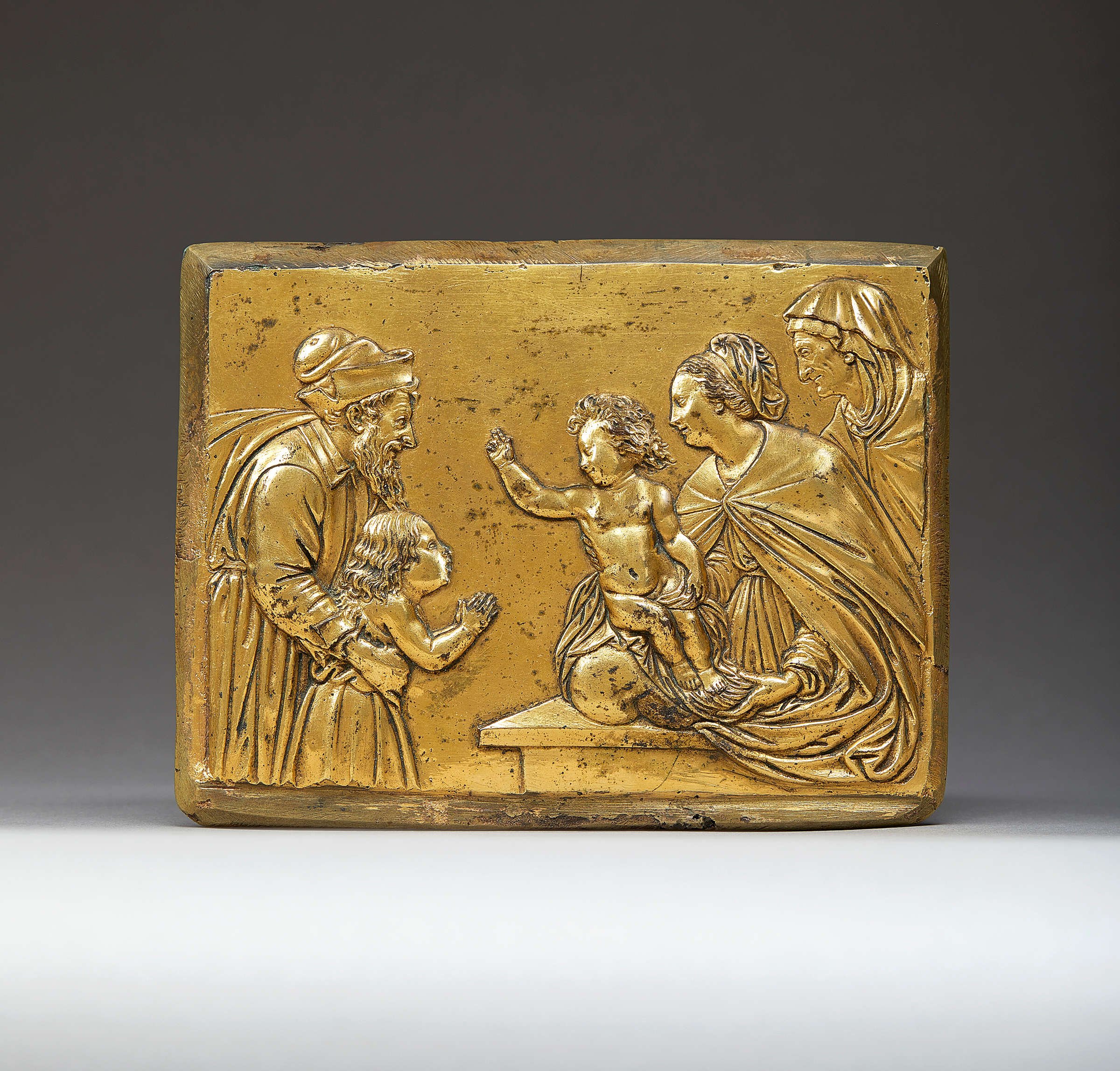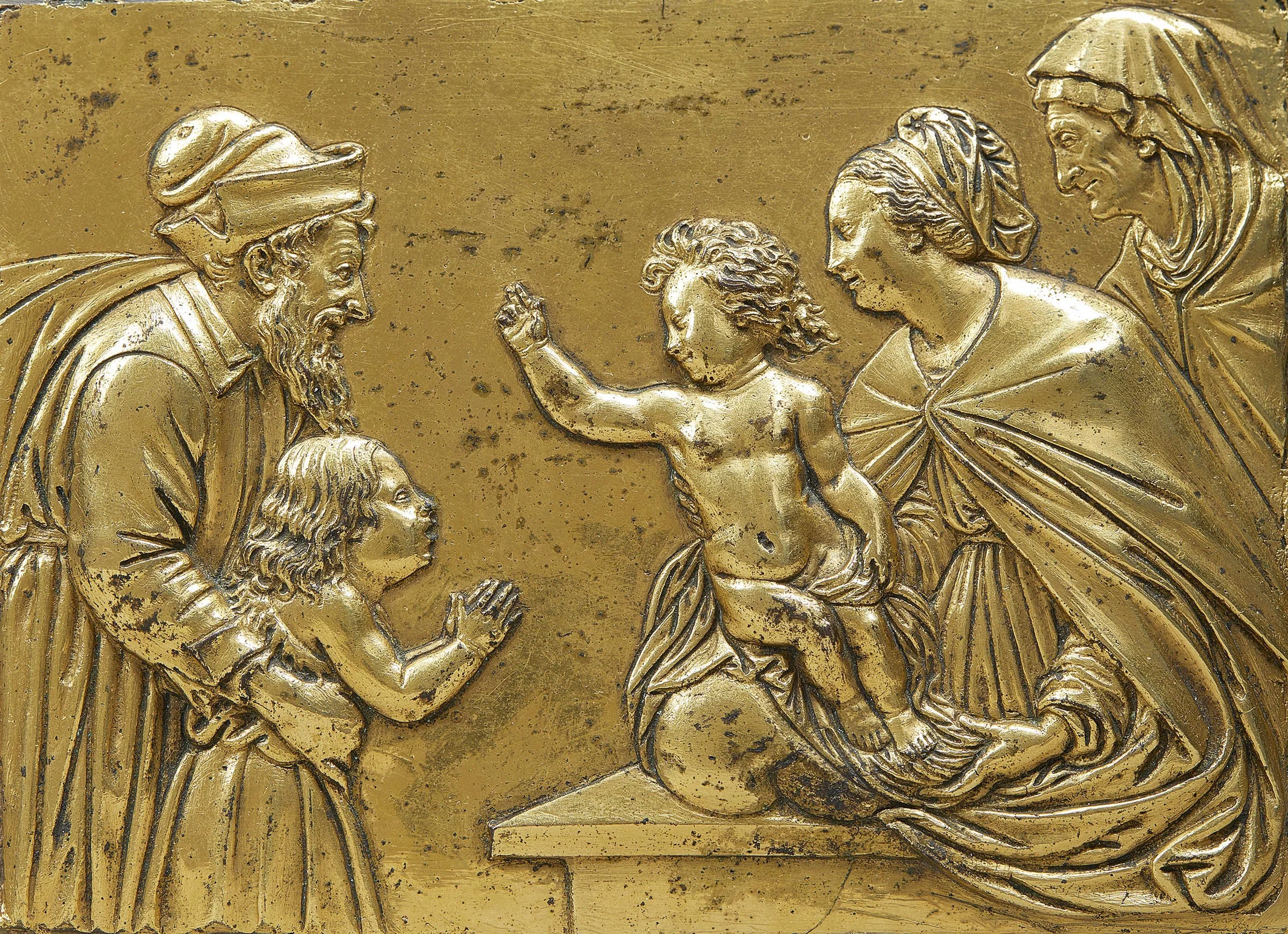Relief of a Sacra Conversazione
Relief of a Sacra Conversazione
Attributed to Barthélemy Prieur (Berzieux, Champagne 1540-1611, Paris)
Circa 1600
Gilt bronze
Dimensions: 17.3 x 13.2 cm. / 6 7/8 x 5 1/4 inches
This outstandingly well-realised narrative plaque, showing Zachariah presenting the infant John the Baptist to the Christ-child, the Virgin and St Anne, was clearly designed to be framed for devotional purposes.
It can be attributed only on the basis of internal evidence, for – seemingly being unpublished - it brings with it no information from earlier scholarly opinion. However, an attentive examination, involving the comparison in style and physical type of all five diverse figures involved in the Sacred Drama independently of one another, leads ineluctably to the conclusion that it is almost certainly a masterwork by Barthélemy Prieur; surprisingly, it may indeed be the first narrative relief to be identified as by him (only two bronze heads in relief are recorded in his inventory of 1583).
Prieur was a French sculptor working in stone and marble who - especially towards the end of his life - specialised in casting bronze statuettes in commercial series. Characteristic of Prieur’s many statuettes and busts of young women – nearly always secular, indeed pagan, classical nymphs or goddesses – is the profile of the face such as is used here for the Virgin Mary: a high forehead sloping back in an almost Grecian continuous line from a small nose, with a receding hairline, while small pursed lips appear above a daintily receding chin. Several of his statuettes of nude women attending to their toilet, one of a maidservant on the way to market and another – probably a wet-nurse – seated to suckle a swaddled baby on her lap, are shown wearing a variety of pleated bonnets, not dissimilar from the more elaborate, perhaps more formal, mob-cap that the Virgin Mary wears here for this important occasion.
Meanwhile, the play of folds, with deep flutes seemingly gouged out of the broader planes of fabric and echoing one another in a profusion of nearly parallel lines, finds close analogies in the clothes of the kneeling Milkmaid with a cow. The divine child is a close cousin in appearance and his bouffant curls – if not in behaviour – of an all-too-human toddler in Prieur’s Mother and Child, who is being gently taught to urinate neatly by his kneeling, nude and attractive young mother; as well as his Running Boy or Cupid, shooting with a bow and arrow. The elderly Zacharias, who leans forward from the left., with his eyes focussed on the Baby Jesus, but meanwhile restraining his son from advancing too eagerly, finds a resonance in a well-known genre-statuette by Prieur of a Vintner with basket, staff and a pruning-hook stuck behind his belt; while a companion of this statuette showing a Peasant-woman carrying a pot on her head (perhaps a fishwife?) provides in her rather severe, lined, face and hooded headgear a prototype for the ageing St Anne, who is shown backing up her daughter from the upper right corner.
In conclusion, the similarities in style, dress and physiognomy to other known works by him support the attribution to Barthélemy Prieur, which would make this beautiful relief a fascinating extension of his known oeuvre.
We are grateful to Dr Charles Avery for his research on the present relief, which is available on request
POA. Please click here to enquire
RELATED LITERATURE:
G. Brière e M.-M. Lamy, 'L'inventaire de Barthélémy Prieur, sculpteur du roi', in Bulletin historique et littéraire de la Société du Protestantisme français, XCVI, (Paris, 1949), pp.41-68); C. Grodecki, Documents du Minutier Central des Notaires de Paris: histoire de l'art aux XVIe siècle (1540-1600), II (Paris, 1986) pp. 129-33; M. Bückling, Die Negervenus, Liebieghaus, Frankfurt-am-Main, 1991; A. Lefebure, “L’atelier de Barthélemy Prieur et l’imagerie royale sous le règne d’Henri IV”, and R. Seelig-Teeuwen, “Barthélemy Prieur, portraitiste d’Henri IV et Marie de Medicis”, in Avènement d’Henri IV, quatrième centenaire, vol. 5, Les arts au temps d’Henri IV, Association Henri IV, 1989 (Pau, 1992); R. Seelig-Teeuwen, 'Barthélemy Prieur, contemporain de Germain Pilon', in Germain Pilon et les sculpteurs français de la Renaissance (Louvre, Conférences et colloques. La Documentation française) (Paris, 1993), pp. 365-85; Anthony Radcliffe, The Robert H. Smith Collection: Bronzes 1500-1600 (London, 1994), pp. 150-55; R. Seelig-Teeuwen, 'Prieur', in The Dictionary of Art, London, 1996, vol. 25, pp. 576-77; R. Seelig-Teeuwen, 'Prieur', in The Encyclopedia of Sculpture (New York/London, 2004), pp. 1362-65



